TAKING
THE WAR TO SWAPO
From 1978 SWAPO adopted the tactic of
"hugging the belt" by placing their camps next to those of their
Angolan and Cuban allies in the forlorn hope that this would deter the South
African Defence Force from attacking them. SWAPO quickly found out that this
tactic did not work, when the SADF attacked and FAPLA and the Cubans got
involved, South Africa would take them on
as well, and invariably got the better of them. The overriding concern of
the South African Military was to minimise South African losses, and 32
Battalion was admirably suited to achieve this aim, as almost 95% of its members
were Angolan. Unita received most of the credit for operations that 32 undertook
against FAPLA in Angola. Most of its operations were conducted in close
cooperation with South African Reconnaissance Commandos, and it is no idle boast
that 32 Battalion was the finest light infantry force in Africa if not the world
in its time. In every contact it was in it had to punch way over its weight,
every time the opposition came off second best , initially a contact rarely
lasted more than a day, sometimes it would be a case of shoot and scoot, but
once the externals started, these would drag out, culminating in those on the
Lomba River, and Cuito Cuanavale, which were
full scale conventional set piece battles.
A lot of intell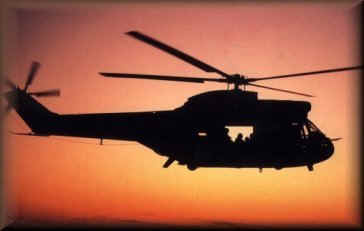 igence
was gleaned as a result of intercepted enemy radio traffic, and in some cases
members of Reco
igence
was gleaned as a result of intercepted enemy radio traffic, and in some cases
members of Reco nnaissance
Commandos would check this out, insertion behind enemy lines took many forms, from
dropping a two man team by helicopter, in many cases the distances involved
would doing this would
be that great that fuel dumps for the insertion had to established hundreds of
kilometres behind the
front line, it was no easy task to man these
forward air bases waiting for the Choppers to return , knowing that if you were
compromised there would be very little one could do except to bombshell and try
to make it back to South African lines.
nnaissance
Commandos would check this out, insertion behind enemy lines took many forms, from
dropping a two man team by helicopter, in many cases the distances involved
would doing this would
be that great that fuel dumps for the insertion had to established hundreds of
kilometres behind the
front line, it was no easy task to man these
forward air bases waiting for the Choppers to return , knowing that if you were
compromised there would be very little one could do except to bombshell and try
to make it back to South African lines.
Some teams were inserted using the Navy's Strike Craft from which rigid Ski-Boats would ferry the operators to shore, if this
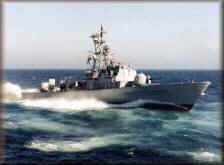
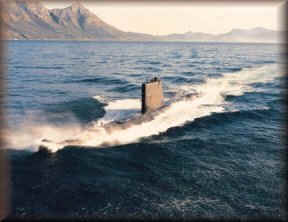 was not possible the Navy would employ its submarines, One factor the
enemy never considered was the fact that the SADF had the capability to use its submarines in this manner. A lot of insertions took place by the simple expedient of walking; there are recorded cases where some of these operators walked over 200 kilometres to get to their target and subsequent operations would be mounted once they exfiltrated, the aim being to disrupt the annual SWAPO offensive in the rainy season, which normally lasted from November to March. Most South African Raids would take place in the dry season, May to September, but to keep SWAPO guessing this rule of thumb would often be disregarded
was not possible the Navy would employ its submarines, One factor the
enemy never considered was the fact that the SADF had the capability to use its submarines in this manner. A lot of insertions took place by the simple expedient of walking; there are recorded cases where some of these operators walked over 200 kilometres to get to their target and subsequent operations would be mounted once they exfiltrated, the aim being to disrupt the annual SWAPO offensive in the rainy season, which normally lasted from November to March. Most South African Raids would take place in the dry season, May to September, but to keep SWAPO guessing this rule of thumb would often be disregarded
It soon became apparent that 32 would be an asset in the gathering of intelligence, it was relatively simple for a platoon using
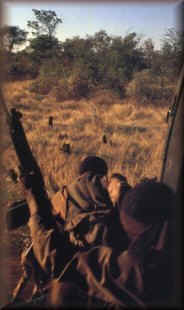 counter-tracking to sneak in and out of SWAPO's backyard without being spotted, but a platoon did not pack sufficient fire-power to engage a company sized force, when the SADF deployed company and battalion sized forces SWAPO's outlying security platoons would invariably detect them, giving SWAPO chance to prepare for an attack without the SADF being aware where SWAPO exactly was. Initially 32 experimented with placing a patrol well ahead of the main body in the hope that they would bump the enemy and flee towards the main force in simulated panic, drawing the SWAPO force into an ambush situation, this practise had mixed results, as SWAPO would not rise to the bait, being well aware of the larger force following.
A reconnaissance wing was created and training took place under the legendary Staff Sergeant "Blue" Kelly who arrived towards the end of 1977, together with Ron Gregory at a base situated at Omauni. Sergeant Major Pep Van Zyl initially helped with the selection in the first few days.Blue Kelly later moved on to Special Forces and had a distinguished career in the this unit. Training was based on Special Forces training with the emphasis on small unit tactics, a typical team would consist of three to five men, dressed in SWAPO kit, and armed with PKM and RPD machine guns, this to give them a edge in fire-power to compensate for their lack of numbers. All white members would "black" up as SWAPO would invariably concentrate their fire on the white members of any patrol they would encounter, knowing that these normally would be the leaders. Special emphasis would be given to demolitions, tracking, advanced medical aid, bush craft, navigation, fire control, small boat handling, especially canoeing, all would be small arms experts and jump qualified. One of those who excelled in this dark art was Willem Rätte, on one recce of a SWAPO base he and his companions cold-bloodedly entered the base when darkness fell, only to discover that the base was being partially vacated, and equipment was being packed in trucks for removal. The three calmly helped dismantle the 14,5 mm weapons and move them to their new positions away from the base. Swapo expected an attack, and wanted the weapons in place to ambush the Puma troop-carrying helicopters of the South African Air Force when they came the next morning. After slipping silently away he radioed headquarters and informed them of the situation. The next morning the Swapo base was destroyed in a successful operation, thanks to his timely warning. He later commanded the intelligence section of 32 Battalion. To say the least, he was unorthodox and eccentric. He was a perfectionist who would let nothing and nobody interfere with a well-planned operation.
counter-tracking to sneak in and out of SWAPO's backyard without being spotted, but a platoon did not pack sufficient fire-power to engage a company sized force, when the SADF deployed company and battalion sized forces SWAPO's outlying security platoons would invariably detect them, giving SWAPO chance to prepare for an attack without the SADF being aware where SWAPO exactly was. Initially 32 experimented with placing a patrol well ahead of the main body in the hope that they would bump the enemy and flee towards the main force in simulated panic, drawing the SWAPO force into an ambush situation, this practise had mixed results, as SWAPO would not rise to the bait, being well aware of the larger force following.
A reconnaissance wing was created and training took place under the legendary Staff Sergeant "Blue" Kelly who arrived towards the end of 1977, together with Ron Gregory at a base situated at Omauni. Sergeant Major Pep Van Zyl initially helped with the selection in the first few days.Blue Kelly later moved on to Special Forces and had a distinguished career in the this unit. Training was based on Special Forces training with the emphasis on small unit tactics, a typical team would consist of three to five men, dressed in SWAPO kit, and armed with PKM and RPD machine guns, this to give them a edge in fire-power to compensate for their lack of numbers. All white members would "black" up as SWAPO would invariably concentrate their fire on the white members of any patrol they would encounter, knowing that these normally would be the leaders. Special emphasis would be given to demolitions, tracking, advanced medical aid, bush craft, navigation, fire control, small boat handling, especially canoeing, all would be small arms experts and jump qualified. One of those who excelled in this dark art was Willem Rätte, on one recce of a SWAPO base he and his companions cold-bloodedly entered the base when darkness fell, only to discover that the base was being partially vacated, and equipment was being packed in trucks for removal. The three calmly helped dismantle the 14,5 mm weapons and move them to their new positions away from the base. Swapo expected an attack, and wanted the weapons in place to ambush the Puma troop-carrying helicopters of the South African Air Force when they came the next morning. After slipping silently away he radioed headquarters and informed them of the situation. The next morning the Swapo base was destroyed in a successful operation, thanks to his timely warning. He later commanded the intelligence section of 32 Battalion. To say the least, he was unorthodox and eccentric. He was a perfectionist who would let nothing and nobody interfere with a well-planned operation.
32 Battalion had the distinction of capturing the only Soviet advisor during the Border War, during Operation Protea, 3 companies of 32 under the command of Commandant James Hills formed part of a stopper group east of Ongiva
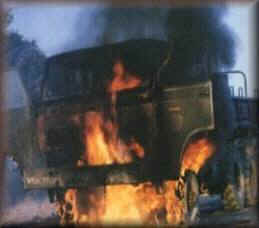 (formerly
Perrier D'Eca), Lieutenant Tinus van Staden spotted a large convoy consisting of BRDM's, tanks and trucks moving towards him from Ongiva. He immediately called for an air strike, and the SAAF
(formerly
Perrier D'Eca), Lieutenant Tinus van Staden spotted a large convoy consisting of BRDM's, tanks and trucks moving towards him from Ongiva. He immediately called for an air strike, and the SAAF
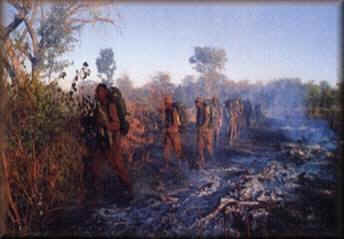 Mirages and Impalas roared in soon
afterwards, leaving a graveyard of shot out vehicles burning and smoking behind them. By the time 32 moved up to sweep the area, it was getting dark, and the 32 soldiers were somewhat surprised to find the bodies of people dressed in Russian uniforms in and amongst the carnage wrought by the air strike, continuing their sweep towards a kraal they were fired upon, immediately the fire was returned and the kraal over run. To their utter amazement they found several more dead Russians amongst them two women, to one side an unwounded Russian Warrant Officer was cradling the body of his dead wife in his arms and weeping, he had been employed as a mechanic at Ongiva. One of the tragedies of wartime played itself out when it was discovered that some of the dead Russians had their children with them, South African Troops immediately organised search parties, and for several days scoured the countryside looking for these children, to no avail, questioning of the local population produced no results, and reluctantly the South African Forces had to abandon the search, and leave the children to their fate.
Mirages and Impalas roared in soon
afterwards, leaving a graveyard of shot out vehicles burning and smoking behind them. By the time 32 moved up to sweep the area, it was getting dark, and the 32 soldiers were somewhat surprised to find the bodies of people dressed in Russian uniforms in and amongst the carnage wrought by the air strike, continuing their sweep towards a kraal they were fired upon, immediately the fire was returned and the kraal over run. To their utter amazement they found several more dead Russians amongst them two women, to one side an unwounded Russian Warrant Officer was cradling the body of his dead wife in his arms and weeping, he had been employed as a mechanic at Ongiva. One of the tragedies of wartime played itself out when it was discovered that some of the dead Russians had their children with them, South African Troops immediately organised search parties, and for several days scoured the countryside looking for these children, to no avail, questioning of the local population produced no results, and reluctantly the South African Forces had to abandon the search, and leave the children to their fate.
During Operation Protea the Recces dropped the bridge at Xangongo, this would make an attack on Cahama by FAPLA well nigh impossible along the west bank of Cunene, the only worry the SADF would have would be the east bank which was
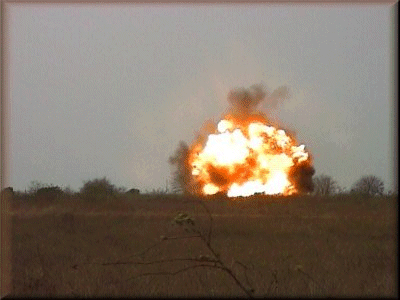 supposedly secured by UNITA, 32 was tasked with clearing the enemy from Calueque to beyond Peu-Peu; one company would operate from Calueque to Humbe, and then to Peu-Peu,
supposedly secured by UNITA, 32 was tasked with clearing the enemy from Calueque to beyond Peu-Peu; one company would operate from Calueque to Humbe, and then to Peu-Peu,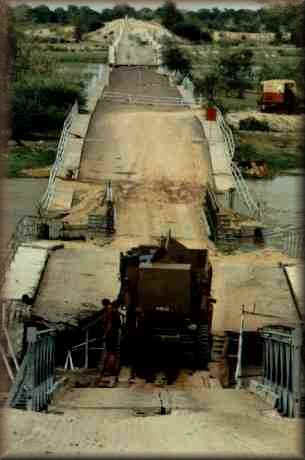 notwithstanding UNITA's assurance that the east bank was secure, it was decided that another company would operate on the east bank of the Cunene. The company operating from Calueque employing butterfly ops quickly killed a lot of badly trained SWAPO auxiliaries, but did not have any luck finding SWAPO bases, and laid up one night south of the Xangongo-Humbe road, the following day the group was ambushed by FAPLA who soon retreated. The Angolan hierarchy decided that this situation was intolerable and decided that they would attack the South African TAC HQ at Peu-Peu, the first thing the SADF knew was when a patrol reported a FAPLA battle group less than 3 kilometres away, between them the only force was a rifle company of 32 and a couple of 81mm mortars, Captain Jan Hougaardt quickly decided to open fire on the FAPLA force with these, rightly assuming that this would delay the enemy long enough to get the SAAF to rescue them, he was correct in his assumption and before long the Impala jets stationed at Ondangwa arrived at the scene and proceeded to rocket and strafe the FAPLA column, at the end of the day more than forty wrecked enemy vehicles littered the Angolan countryside. Those FAPLA troops who survived retreated on foot to the north or to Cahama. Later on a similar advance from Cahama was attempted by FAPLA, but this time the South Africans would be prepared and this attack on Xangongo, like its predecessor would be stopped cold.
notwithstanding UNITA's assurance that the east bank was secure, it was decided that another company would operate on the east bank of the Cunene. The company operating from Calueque employing butterfly ops quickly killed a lot of badly trained SWAPO auxiliaries, but did not have any luck finding SWAPO bases, and laid up one night south of the Xangongo-Humbe road, the following day the group was ambushed by FAPLA who soon retreated. The Angolan hierarchy decided that this situation was intolerable and decided that they would attack the South African TAC HQ at Peu-Peu, the first thing the SADF knew was when a patrol reported a FAPLA battle group less than 3 kilometres away, between them the only force was a rifle company of 32 and a couple of 81mm mortars, Captain Jan Hougaardt quickly decided to open fire on the FAPLA force with these, rightly assuming that this would delay the enemy long enough to get the SAAF to rescue them, he was correct in his assumption and before long the Impala jets stationed at Ondangwa arrived at the scene and proceeded to rocket and strafe the FAPLA column, at the end of the day more than forty wrecked enemy vehicles littered the Angolan countryside. Those FAPLA troops who survived retreated on foot to the north or to Cahama. Later on a similar advance from Cahama was attempted by FAPLA, but this time the South Africans would be prepared and this attack on Xangongo, like its predecessor would be stopped cold.
OPERATION SUPER
One of the reasons 32 was so successful was the fact that unlike National Servicemen or Citizen Force Campers, they stayed in the Operational Area constantly, a typical deployment would be 3 months continuous operations, followed by rest and recuperation at Buffalo base, but even then there would be training during this "rest" period. 32 Battalion troops therefore did not have to acclimatise the same way other South African troops had to, most of these soldiers had been fighting side by side since the late '70's. One example might illustrate the fighting prowess of this unique unit
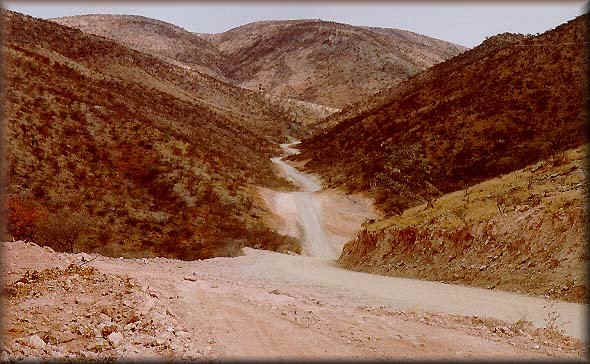 One of the most successful strikes against SWAPO took place during March 1982, 32 had been asked to support a reconnaissance mission that 5 Recce had been tasked with, as most of 32 had been rotated back to Buffalo after 3 months non stop patrolling and fighting, the best that Jan Hougaardt
One of the most successful strikes against SWAPO took place during March 1982, 32 had been asked to support a reconnaissance mission that 5 Recce had been tasked with, as most of 32 had been rotated back to Buffalo after 3 months non stop patrolling and fighting, the best that Jan Hougaardt
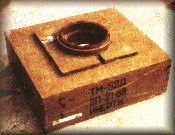 at TAC HQ at Ruacana could was to scrape a platoon together and this motley crew flew out to Marienfluss in the Kaokoveld. The Recce team leader had received intelligence that there might be a possible SWAPO presence in the Cambeno valley close to an abandoned Portuguese settlement called Iona. The 32 troops were only geared up to assist the Recce team if this should be necessary, nobody anticipated that this would turn out to be the start of a battle of epic proportions. In addition to the two Puma Choppers that had brought the 32 platoon, two gunships had flown in with Neall Ellis.
at TAC HQ at Ruacana could was to scrape a platoon together and this motley crew flew out to Marienfluss in the Kaokoveld. The Recce team leader had received intelligence that there might be a possible SWAPO presence in the Cambeno valley close to an abandoned Portuguese settlement called Iona. The 32 troops were only geared up to assist the Recce team if this should be necessary, nobody anticipated that this would turn out to be the start of a battle of epic proportions. In addition to the two Puma Choppers that had brought the 32 platoon, two gunships had flown in with Neall Ellis.
The Recces were dropped east of the point where the road entered the mountains, and quickly ascertained that there was
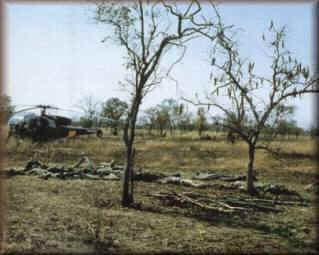 considerable road traffic, and this could only be SWAPO logistical vehicles,
a
considerable road traffic, and this could only be SWAPO logistical vehicles,
a nd the Recces planted a TM 62 anti-tank mine, and retired to a koppie about a
kilometre away keeping the site of the landmine under observation. A while later two SWAPO trucks came down the road, and one detonated the mine, but it did ot seem to cause any casualties, the survivors simply climbed on to the remaining truck, and this drove off. Later on that afternoon a 28 men strong SWAPO patrol approached from the east, and once they reached the site of the mined truck, started casting around for spoor, unfortunately the Recces' anti-tracking measures were not sufficient, and it soon became apparent that the SWAPO patrol had found the South Africans' tracks and were following these towards where the Recces were lying up, the Recces contacted TAC HQ at Marienfluss informing them that they were compromised, and would require assistance, as there was no means they could get away undetected.
nd the Recces planted a TM 62 anti-tank mine, and retired to a koppie about a
kilometre away keeping the site of the landmine under observation. A while later two SWAPO trucks came down the road, and one detonated the mine, but it did ot seem to cause any casualties, the survivors simply climbed on to the remaining truck, and this drove off. Later on that afternoon a 28 men strong SWAPO patrol approached from the east, and once they reached the site of the mined truck, started casting around for spoor, unfortunately the Recces' anti-tracking measures were not sufficient, and it soon became apparent that the SWAPO patrol had found the South Africans' tracks and were following these towards where the Recces were lying up, the Recces contacted TAC HQ at Marienfluss informing them that they were compromised, and would require assistance, as there was no means they could get away undetected.
The Recce leader realised he had to play for time, and as soon as the SWAPO patrol came within earshot he passed him and
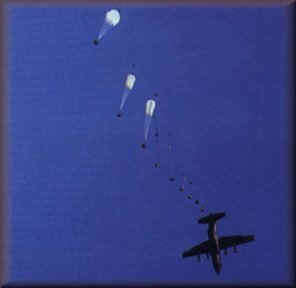 his men off as SWAPO, and accused them (the real SWAPO) of being UNITA trying to locate his base camp, this bold ruse threw the SWAPO leader somewhat, and a animated argument developed between the two leaders as to who was in fact the "Boers". The Recce decided that this argument was
his men off as SWAPO, and accused them (the real SWAPO) of being UNITA trying to locate his base camp, this bold ruse threw the SWAPO leader somewhat, and a animated argument developed between the two leaders as to who was in fact the "Boers". The Recce decided that this argument was getting rather boring and realised that there was no future in this, and shot the SWAPO commander in the face, as he shot his opponent, his men opened fire. The Recces soon realised that they were in for the fight of their lives, and the sound of the Allouette Gunships' 20mm blasting the enemy around the hill was music to their ears, in the meantime the 32 Romeo Mike team had been deployed in a skirmish line, and started sweeping up the hill, when the firing stopped 21 SWAPO lay dead, 6 wounded were captured and 1 got away. The wounded Terrs were casevaced to Marienfluss and once interrogated revealed that SWAPO had in fact a camp on the course of the dried up Humbi river in the Cambeno valley. In the meantime Sector 10 at Oshakati was busy organising extra troop reinforcements and Gunships.The choppers at Marienfluss were low on fuel and it was decided to fly in fuel and from the Republic but as their was no airstrip large enough to take the C160 bringing in the fuel it had to land at the nearby Nangola Flats, whilst this was going on another platoon and 81mm mortar team from 32 were flown in for the follow-up operation. After the choppers had refuelled, 4 Allouette gunships and 5 Pumas carrying the 32 troops set off to eliminate the base
getting rather boring and realised that there was no future in this, and shot the SWAPO commander in the face, as he shot his opponent, his men opened fire. The Recces soon realised that they were in for the fight of their lives, and the sound of the Allouette Gunships' 20mm blasting the enemy around the hill was music to their ears, in the meantime the 32 Romeo Mike team had been deployed in a skirmish line, and started sweeping up the hill, when the firing stopped 21 SWAPO lay dead, 6 wounded were captured and 1 got away. The wounded Terrs were casevaced to Marienfluss and once interrogated revealed that SWAPO had in fact a camp on the course of the dried up Humbi river in the Cambeno valley. In the meantime Sector 10 at Oshakati was busy organising extra troop reinforcements and Gunships.The choppers at Marienfluss were low on fuel and it was decided to fly in fuel and from the Republic but as their was no airstrip large enough to take the C160 bringing in the fuel it had to land at the nearby Nangola Flats, whilst this was going on another platoon and 81mm mortar team from 32 were flown in for the follow-up operation. After the choppers had refuelled, 4 Allouette gunships and 5 Pumas carrying the 32 troops set off to eliminate the base
As they approached the target area the task force flew into a thunderstorm which reduced visibility to nil, and reluctantly they had to turn back, back at Sector 10 HQ it was decided to scrub the whole plan as the choppers had been close enough for SWAPO to have heard them, the consensus was that by now the camp would have been evacuated, fortunately Jan Hougaardt insisted that SWAPO had not done so, the trail watchers he had positioned on the track north had reported no SWAPO activity along this, finally Sector 10 HQ agreed that an attack could be mounted the following day, 13 March 1982.
When th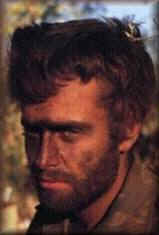 e Gunships arrived at where the SWAPO base was thought to be, there was nothing to be seen, and they circled in vain looking
for any sign of activity amongst the sparse thorn scrub without any luck, just as they were about to turn back the Flight Engineer of Neall Ellis, Sergeant Steve Coetzee noticed strange starfish formations radiating from bushes, suddenly he realised what this was, it was SWAPO lying underneath these bushes hoping they would not be spotted, and then everything clicked into place, what he had thought was brown rocks was in fact bivouacs. As soon as the Gunships opened fire SWAPO realised that the game was up, and opened fire on the Allouette's with everything they had, the air was filled with exploding RPG7 rockets, and green tracer from SWAPO arcing upwards and the red tracer from the gunships crisscrossing the early morning sky, The Pumas had dropped off the 32 Battalion assault force, numbering 40 men. Some were dropped as close as 50 metres away from the enemy, the 40 32-Battalion members shook themselves out in assault formation and commenced advancing towards the enemy, fortunately SWAPO had made the fundamental error of situating their base in a narrow valley, overlooked by high ground on all sides, a mistake that would cost them dearly
e Gunships arrived at where the SWAPO base was thought to be, there was nothing to be seen, and they circled in vain looking
for any sign of activity amongst the sparse thorn scrub without any luck, just as they were about to turn back the Flight Engineer of Neall Ellis, Sergeant Steve Coetzee noticed strange starfish formations radiating from bushes, suddenly he realised what this was, it was SWAPO lying underneath these bushes hoping they would not be spotted, and then everything clicked into place, what he had thought was brown rocks was in fact bivouacs. As soon as the Gunships opened fire SWAPO realised that the game was up, and opened fire on the Allouette's with everything they had, the air was filled with exploding RPG7 rockets, and green tracer from SWAPO arcing upwards and the red tracer from the gunships crisscrossing the early morning sky, The Pumas had dropped off the 32 Battalion assault force, numbering 40 men. Some were dropped as close as 50 metres away from the enemy, the 40 32-Battalion members shook themselves out in assault formation and commenced advancing towards the enemy, fortunately SWAPO had made the fundamental error of situating their base in a narrow valley, overlooked by high ground on all sides, a mistake that would cost them dearly
40 against 300 ..............
The mortar group was dropped off on a nearby hill to give covering fire,
To even the odds the Pumas went and picked up the trail watchers who numbered 20 and brought them back, these stopper groups were
d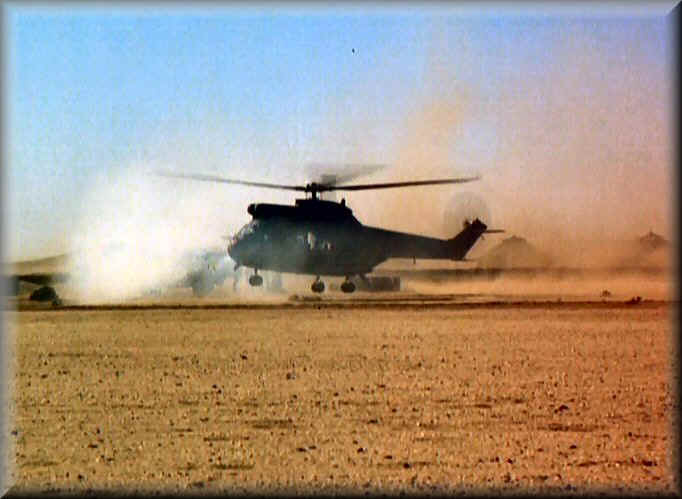 ropped on the high ground to block all escape routes, these groups would wreak havoc amongst those SWAPO who decided
to gap it. The terrain was a nightmare, rugged with rocks, valleys, cliff faces,
do
ropped on the high ground to block all escape routes, these groups would wreak havoc amongst those SWAPO who decided
to gap it. The terrain was a nightmare, rugged with rocks, valleys, cliff faces,
do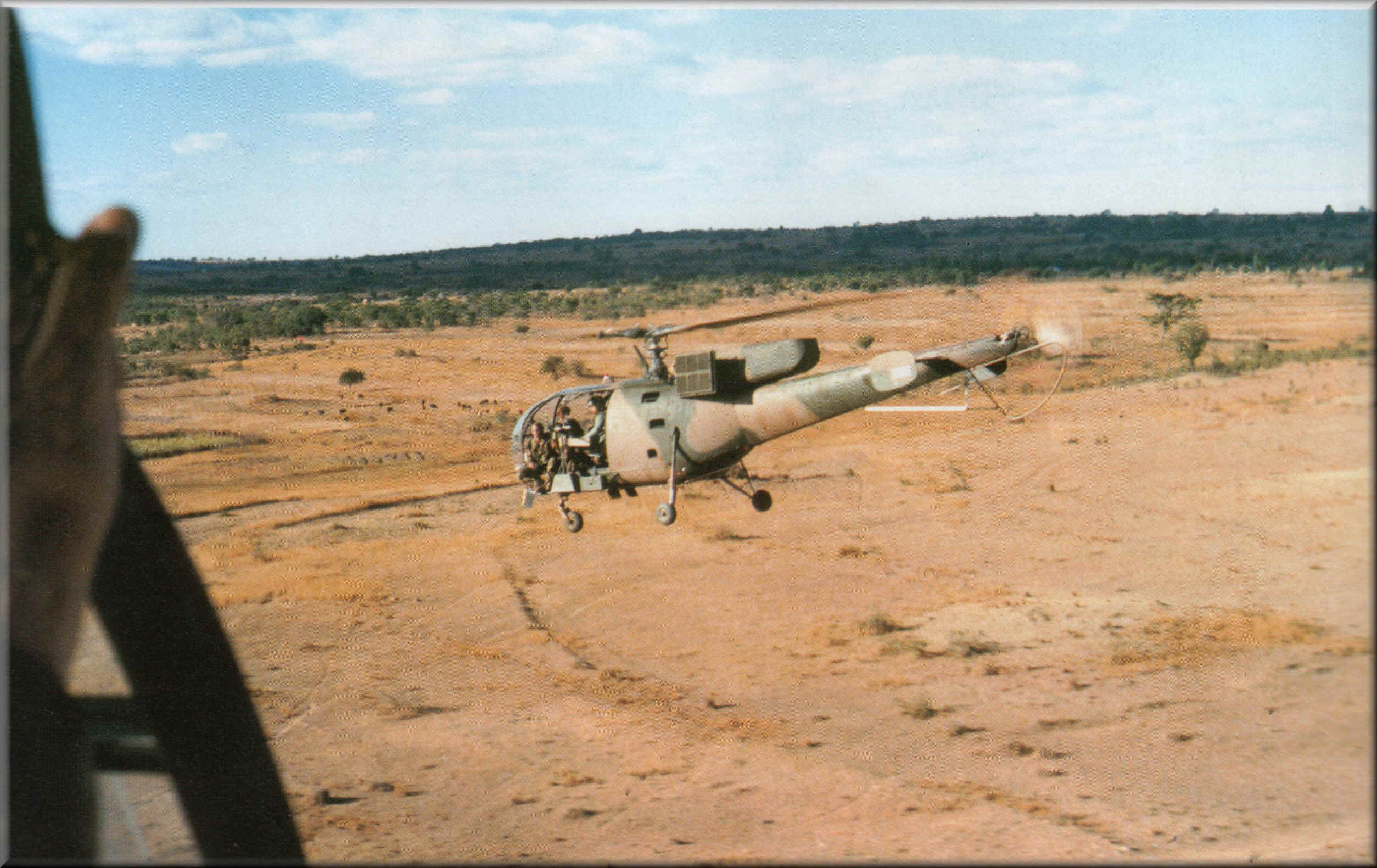 ngas, a soldier's nightmare. As 32 advanced
they were constantly under intense small-arms fire, every yard gained was in the teeth of determined resistance, there was no doubting SWAPO's willingness to stand and fight. The action started at 08H00 and by 13H00 it was still going as
fiercely as ever, the two protagonists slogging it out, bloody fire fights scattered along the assault line as 32 kept up its remorseless advance. Whenever the gunships opened fire with their 20mm cannon it was the unenviable task of the 32 Battalion soldier to reach down and fight in the crevices and crannies where SWAPO would take cover from the gunships .The Allouette's were constantly under RPG-7 rocket fire, and at least 4 SAM-7 were fired at them, fortunately they were to low for the infra-red guided warhead to lock onto their exhaust signature.
ngas, a soldier's nightmare. As 32 advanced
they were constantly under intense small-arms fire, every yard gained was in the teeth of determined resistance, there was no doubting SWAPO's willingness to stand and fight. The action started at 08H00 and by 13H00 it was still going as
fiercely as ever, the two protagonists slogging it out, bloody fire fights scattered along the assault line as 32 kept up its remorseless advance. Whenever the gunships opened fire with their 20mm cannon it was the unenviable task of the 32 Battalion soldier to reach down and fight in the crevices and crannies where SWAPO would take cover from the gunships .The Allouette's were constantly under RPG-7 rocket fire, and at least 4 SAM-7 were fired at them, fortunately they were to low for the infra-red guided warhead to lock onto their exhaust signature.
The fight carried on through the rest of the day and well into the night, by this time most of the South Africans' ammunition was exhausted, and they had to make do by using ammunition and weapons taken off the dead SWAPO, back at the HAA 5 kilometres away some Pumas were grounded due to a lack of fuel, but by morning it was all over, and 201 dead SWAPO bodies littered
t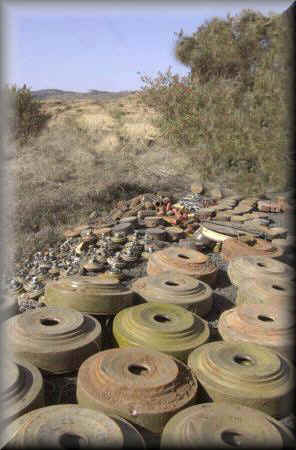 he valley floor, many were wounded and there was a significant number of captures
he valley floor, many were wounded and there was a significant number of captures
32 lost 3 men KIA, and an unknown number of wounded, 3 Honoris Crux were awarded to its members, another 2 to members of the SAAF. When the base was examined the following morning the
South Africans could not believe their eyes, it was a virtual Aladdin's cave with tons upon tons of weapons, equipment and food.
This ranged from AK47's to Sam-7 missiles, mines to medicine, mealiemeal to gherkins, Radios to Zodiac inflatable boats. Sixty tons of this haul was flown out to Marienfluss, and the rest destroyed in situ. Interrogation of the captured Terrs revealed that they had planned to use this base as a staging post to infiltrate Outjo and the farming communities farther south
GALLERY
These SWAPO okies never
managed to take their places in the Namibian Parliament
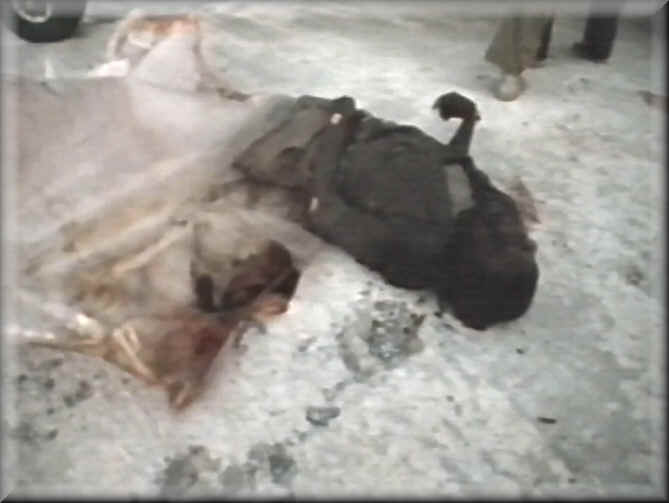

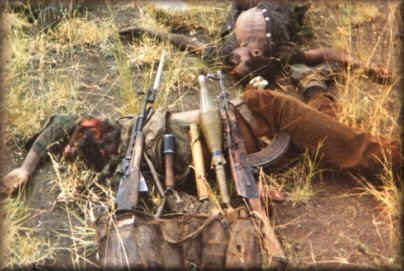
ON PARADE
32 Trooping their colours
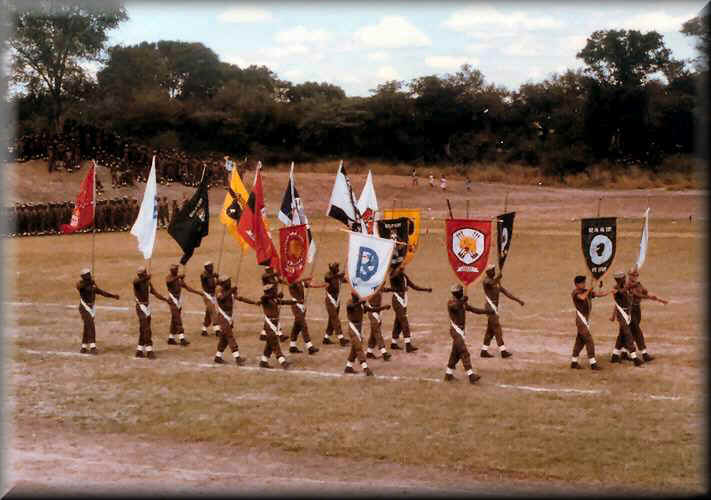
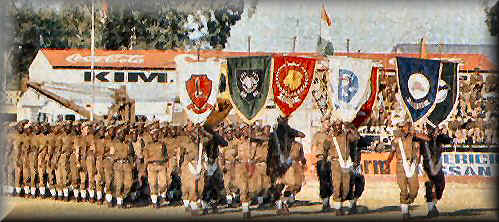
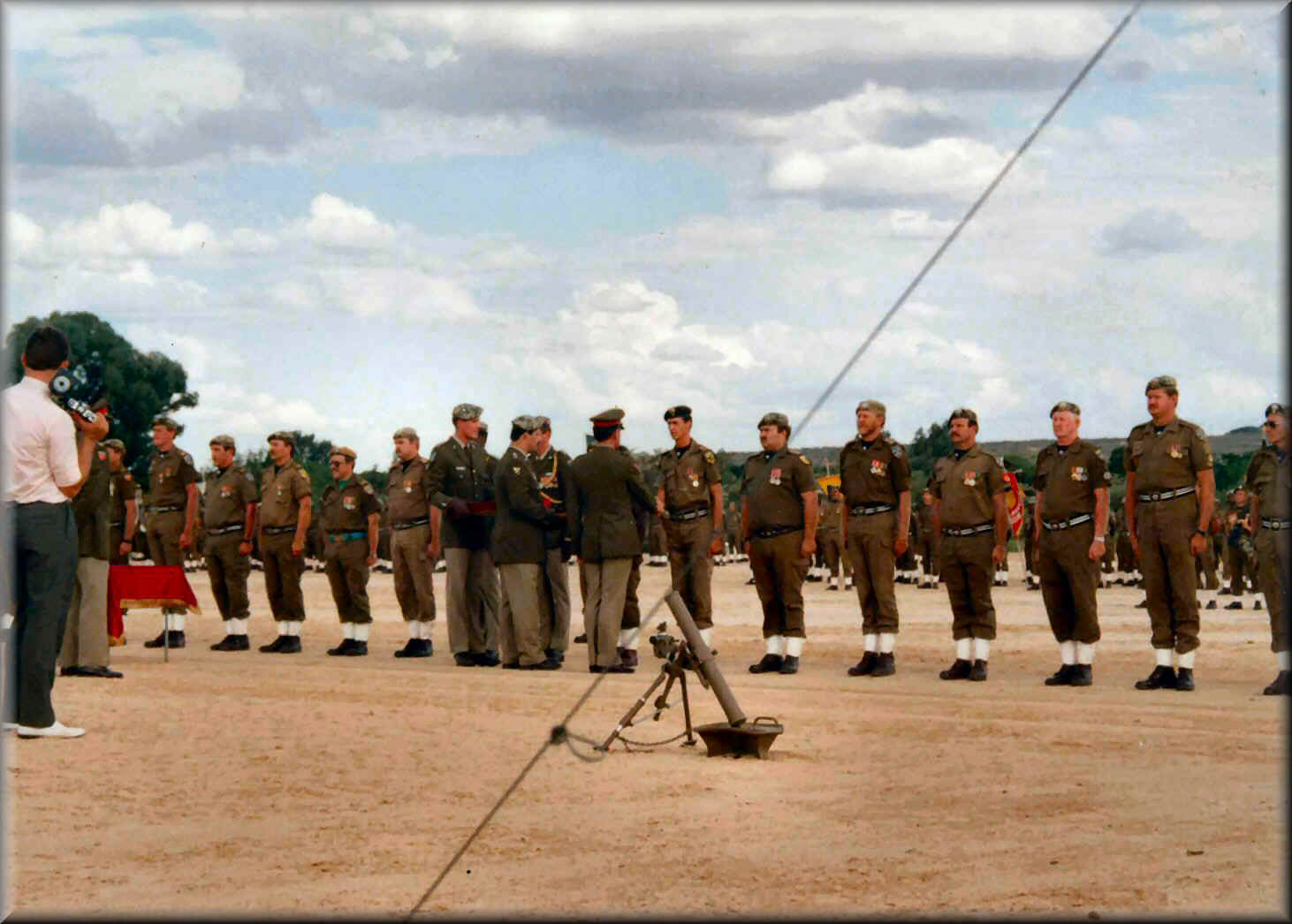

OPS
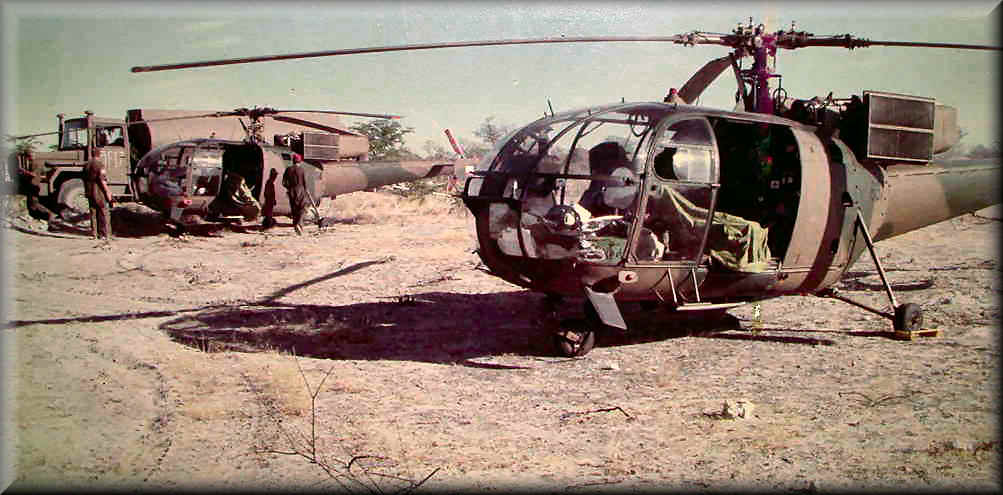

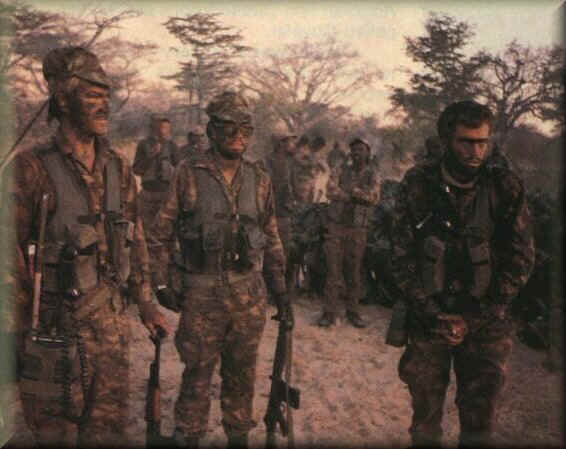
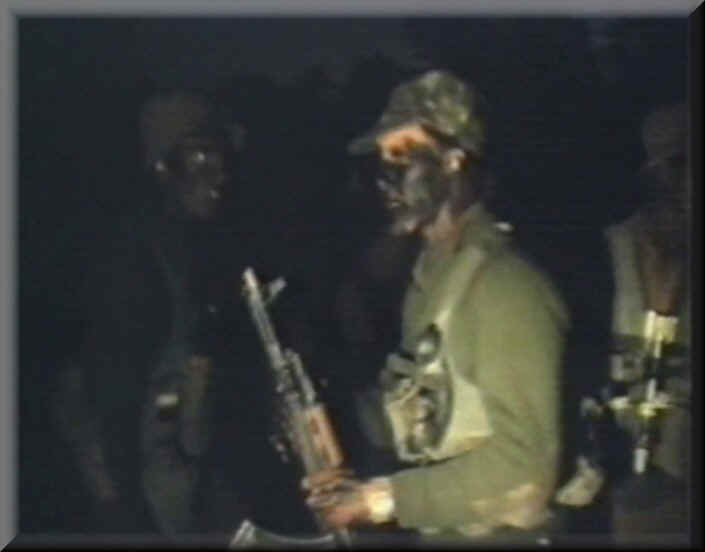



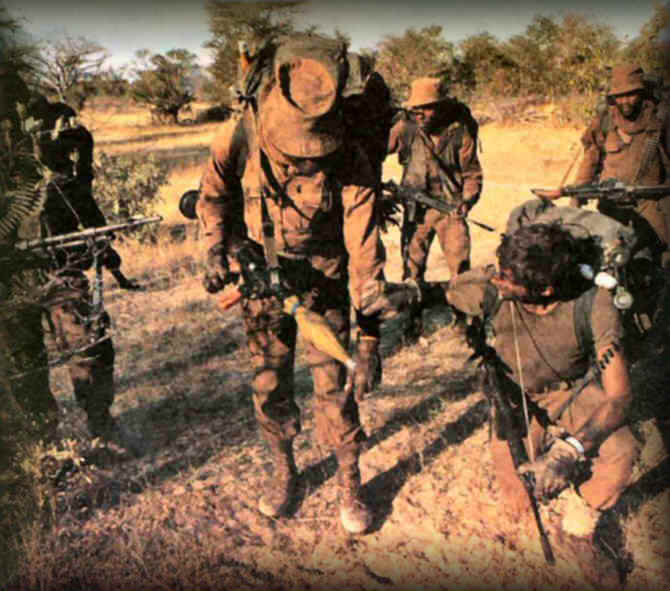
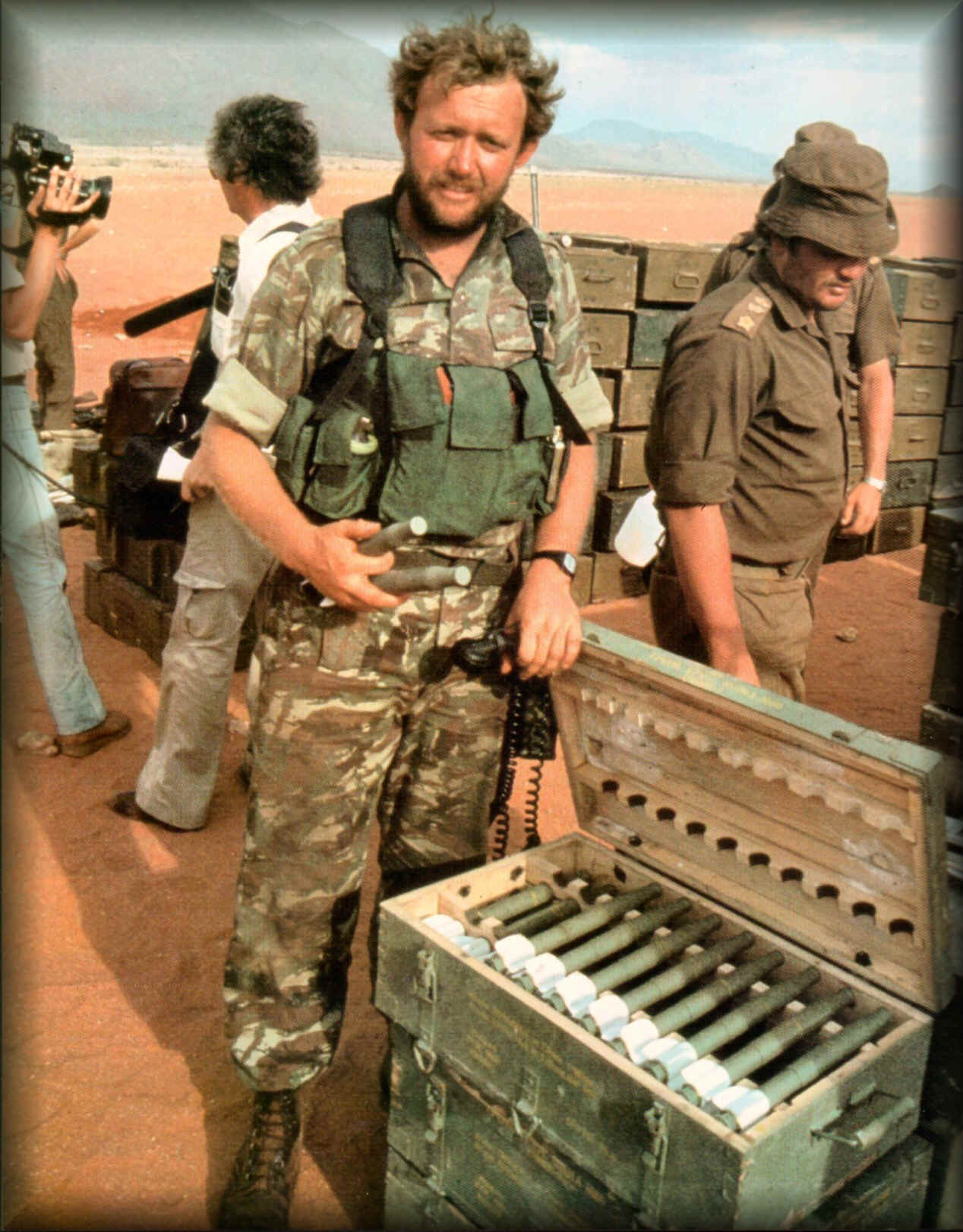 ..
..


Back
Copyright Cobus Venter 2006
 igence
was gleaned as a result of intercepted enemy radio traffic, and in some cases
members of Reco
igence
was gleaned as a result of intercepted enemy radio traffic, and in some cases
members of Reco nnaissance
Commandos would check this out, insertion behind enemy lines took many forms, from
dropping a two man team by helicopter, in many cases the distances involved
would doing this would
be that great that fuel dumps for the insertion had to established hundreds of
kilometres behind the
front line, it was no easy task to man these
forward air bases waiting for the Choppers to return , knowing that if you were
compromised there would be very little one could do except to bombshell and try
to make it back to South African lines.
nnaissance
Commandos would check this out, insertion behind enemy lines took many forms, from
dropping a two man team by helicopter, in many cases the distances involved
would doing this would
be that great that fuel dumps for the insertion had to established hundreds of
kilometres behind the
front line, it was no easy task to man these
forward air bases waiting for the Choppers to return , knowing that if you were
compromised there would be very little one could do except to bombshell and try
to make it back to South African lines.
 was not possible the Navy would employ its submarines, One factor the
enemy never considered was the fact that the SADF had the capability to use its submarines in this manner. A lot of insertions took place by the simple expedient of walking; there are recorded cases where some of these operators walked over 200 kilometres to get to their target and subsequent operations would be mounted once they exfiltrated, the aim being to disrupt the annual SWAPO offensive in the rainy season, which normally lasted from November to March. Most South African Raids would take place in the dry season, May to September, but to keep SWAPO guessing this rule of thumb would often be disregarded
was not possible the Navy would employ its submarines, One factor the
enemy never considered was the fact that the SADF had the capability to use its submarines in this manner. A lot of insertions took place by the simple expedient of walking; there are recorded cases where some of these operators walked over 200 kilometres to get to their target and subsequent operations would be mounted once they exfiltrated, the aim being to disrupt the annual SWAPO offensive in the rainy season, which normally lasted from November to March. Most South African Raids would take place in the dry season, May to September, but to keep SWAPO guessing this rule of thumb would often be disregarded counter-tracking to sneak in and out of SWAPO's backyard without being spotted, but a platoon did not pack sufficient fire-power to engage a company sized force, when the SADF deployed company and battalion sized forces SWAPO's outlying security platoons would invariably detect them, giving SWAPO chance to prepare for an attack without the SADF being aware where SWAPO exactly was. Initially 32 experimented with placing a patrol well ahead of the main body in the hope that they would bump the enemy and flee towards the main force in simulated panic, drawing the SWAPO force into an ambush situation, this practise had mixed results, as SWAPO would not rise to the bait, being well aware of the larger force following.
A reconnaissance wing was created and training took place under the legendary Staff Sergeant "Blue" Kelly who arrived towards the end of 1977, together with Ron Gregory at a base situated at Omauni. Sergeant Major Pep Van Zyl initially helped with the selection in the first few days.Blue Kelly later moved on to Special Forces and had a distinguished career in the this unit. Training was based on Special Forces training with the emphasis on small unit tactics, a typical team would consist of three to five men, dressed in SWAPO kit, and armed with PKM and RPD machine guns, this to give them a edge in fire-power to compensate for their lack of numbers. All white members would "black" up as SWAPO would invariably concentrate their fire on the white members of any patrol they would encounter, knowing that these normally would be the leaders. Special emphasis would be given to demolitions, tracking, advanced medical aid, bush craft, navigation, fire control, small boat handling, especially canoeing, all would be small arms experts and jump qualified. One of those who excelled in this dark art was Willem Rätte, on one recce of a SWAPO base he and his companions cold-bloodedly entered the base when darkness fell, only to discover that the base was being partially vacated, and equipment was being packed in trucks for removal. The three calmly helped dismantle the 14,5 mm weapons and move them to their new positions away from the base. Swapo expected an attack, and wanted the weapons in place to ambush the Puma troop-carrying helicopters of the South African Air Force when they came the next morning. After slipping silently away he radioed headquarters and informed them of the situation. The next morning the Swapo base was destroyed in a successful operation, thanks to his timely warning. He later commanded the intelligence section of 32 Battalion. To say the least, he was unorthodox and eccentric. He was a perfectionist who would let nothing and nobody interfere with a well-planned operation.
counter-tracking to sneak in and out of SWAPO's backyard without being spotted, but a platoon did not pack sufficient fire-power to engage a company sized force, when the SADF deployed company and battalion sized forces SWAPO's outlying security platoons would invariably detect them, giving SWAPO chance to prepare for an attack without the SADF being aware where SWAPO exactly was. Initially 32 experimented with placing a patrol well ahead of the main body in the hope that they would bump the enemy and flee towards the main force in simulated panic, drawing the SWAPO force into an ambush situation, this practise had mixed results, as SWAPO would not rise to the bait, being well aware of the larger force following.
A reconnaissance wing was created and training took place under the legendary Staff Sergeant "Blue" Kelly who arrived towards the end of 1977, together with Ron Gregory at a base situated at Omauni. Sergeant Major Pep Van Zyl initially helped with the selection in the first few days.Blue Kelly later moved on to Special Forces and had a distinguished career in the this unit. Training was based on Special Forces training with the emphasis on small unit tactics, a typical team would consist of three to five men, dressed in SWAPO kit, and armed with PKM and RPD machine guns, this to give them a edge in fire-power to compensate for their lack of numbers. All white members would "black" up as SWAPO would invariably concentrate their fire on the white members of any patrol they would encounter, knowing that these normally would be the leaders. Special emphasis would be given to demolitions, tracking, advanced medical aid, bush craft, navigation, fire control, small boat handling, especially canoeing, all would be small arms experts and jump qualified. One of those who excelled in this dark art was Willem Rätte, on one recce of a SWAPO base he and his companions cold-bloodedly entered the base when darkness fell, only to discover that the base was being partially vacated, and equipment was being packed in trucks for removal. The three calmly helped dismantle the 14,5 mm weapons and move them to their new positions away from the base. Swapo expected an attack, and wanted the weapons in place to ambush the Puma troop-carrying helicopters of the South African Air Force when they came the next morning. After slipping silently away he radioed headquarters and informed them of the situation. The next morning the Swapo base was destroyed in a successful operation, thanks to his timely warning. He later commanded the intelligence section of 32 Battalion. To say the least, he was unorthodox and eccentric. He was a perfectionist who would let nothing and nobody interfere with a well-planned operation. (formerly
Perrier D'Eca), Lieutenant Tinus van Staden spotted a large convoy consisting of BRDM's, tanks and trucks moving towards him from Ongiva. He immediately called for an air strike, and the SAAF
(formerly
Perrier D'Eca), Lieutenant Tinus van Staden spotted a large convoy consisting of BRDM's, tanks and trucks moving towards him from Ongiva. He immediately called for an air strike, and the SAAF
 Mirages and Impalas roared in soon
afterwards, leaving a graveyard of shot out vehicles burning and smoking behind them. By the time 32 moved up to sweep the area, it was getting dark, and the 32 soldiers were somewhat surprised to find the bodies of people dressed in Russian uniforms in and amongst the carnage wrought by the air strike, continuing their sweep towards a kraal they were fired upon, immediately the fire was returned and the kraal over run. To their utter amazement they found several more dead Russians amongst them two women, to one side an unwounded Russian Warrant Officer was cradling the body of his dead wife in his arms and weeping, he had been employed as a mechanic at Ongiva. One of the tragedies of wartime played itself out when it was discovered that some of the dead Russians had their children with them, South African Troops immediately organised search parties, and for several days scoured the countryside looking for these children, to no avail, questioning of the local population produced no results, and reluctantly the South African Forces had to abandon the search, and leave the children to their fate.
Mirages and Impalas roared in soon
afterwards, leaving a graveyard of shot out vehicles burning and smoking behind them. By the time 32 moved up to sweep the area, it was getting dark, and the 32 soldiers were somewhat surprised to find the bodies of people dressed in Russian uniforms in and amongst the carnage wrought by the air strike, continuing their sweep towards a kraal they were fired upon, immediately the fire was returned and the kraal over run. To their utter amazement they found several more dead Russians amongst them two women, to one side an unwounded Russian Warrant Officer was cradling the body of his dead wife in his arms and weeping, he had been employed as a mechanic at Ongiva. One of the tragedies of wartime played itself out when it was discovered that some of the dead Russians had their children with them, South African Troops immediately organised search parties, and for several days scoured the countryside looking for these children, to no avail, questioning of the local population produced no results, and reluctantly the South African Forces had to abandon the search, and leave the children to their fate. supposedly secured by UNITA, 32 was tasked with clearing the enemy from Calueque to beyond Peu-Peu; one company would operate from Calueque to Humbe, and then to Peu-Peu,
supposedly secured by UNITA, 32 was tasked with clearing the enemy from Calueque to beyond Peu-Peu; one company would operate from Calueque to Humbe, and then to Peu-Peu, notwithstanding UNITA's assurance that the east bank was secure, it was decided that another company would operate on the east bank of the Cunene. The company operating from Calueque employing butterfly ops quickly killed a lot of badly trained SWAPO auxiliaries, but did not have any luck finding SWAPO bases, and laid up one night south of the Xangongo-Humbe road, the following day the group was ambushed by FAPLA who soon retreated. The Angolan hierarchy decided that this situation was intolerable and decided that they would attack the South African TAC HQ at Peu-Peu, the first thing the SADF knew was when a patrol reported a FAPLA battle group less than 3 kilometres away, between them the only force was a rifle company of 32 and a couple of 81mm mortars, Captain Jan Hougaardt quickly decided to open fire on the FAPLA force with these, rightly assuming that this would delay the enemy long enough to get the SAAF to rescue them, he was correct in his assumption and before long the Impala jets stationed at Ondangwa arrived at the scene and proceeded to rocket and strafe the FAPLA column, at the end of the day more than forty wrecked enemy vehicles littered the Angolan countryside. Those FAPLA troops who survived retreated on foot to the north or to Cahama. Later on a similar advance from Cahama was attempted by FAPLA, but this time the South Africans would be prepared and this attack on Xangongo, like its predecessor would be stopped cold.
notwithstanding UNITA's assurance that the east bank was secure, it was decided that another company would operate on the east bank of the Cunene. The company operating from Calueque employing butterfly ops quickly killed a lot of badly trained SWAPO auxiliaries, but did not have any luck finding SWAPO bases, and laid up one night south of the Xangongo-Humbe road, the following day the group was ambushed by FAPLA who soon retreated. The Angolan hierarchy decided that this situation was intolerable and decided that they would attack the South African TAC HQ at Peu-Peu, the first thing the SADF knew was when a patrol reported a FAPLA battle group less than 3 kilometres away, between them the only force was a rifle company of 32 and a couple of 81mm mortars, Captain Jan Hougaardt quickly decided to open fire on the FAPLA force with these, rightly assuming that this would delay the enemy long enough to get the SAAF to rescue them, he was correct in his assumption and before long the Impala jets stationed at Ondangwa arrived at the scene and proceeded to rocket and strafe the FAPLA column, at the end of the day more than forty wrecked enemy vehicles littered the Angolan countryside. Those FAPLA troops who survived retreated on foot to the north or to Cahama. Later on a similar advance from Cahama was attempted by FAPLA, but this time the South Africans would be prepared and this attack on Xangongo, like its predecessor would be stopped cold. One of the most successful strikes against SWAPO took place during March 1982, 32 had been asked to support a reconnaissance mission that 5 Recce had been tasked with, as most of 32 had been rotated back to Buffalo after 3 months non stop patrolling and fighting, the best that Jan Hougaardt
One of the most successful strikes against SWAPO took place during March 1982, 32 had been asked to support a reconnaissance mission that 5 Recce had been tasked with, as most of 32 had been rotated back to Buffalo after 3 months non stop patrolling and fighting, the best that Jan Hougaardt
 at TAC HQ at Ruacana could was to scrape a platoon together and this motley crew flew out to Marienfluss in the Kaokoveld. The Recce team leader had received intelligence that there might be a possible SWAPO presence in the Cambeno valley close to an abandoned Portuguese settlement called Iona. The 32 troops were only geared up to assist the Recce team if this should be necessary, nobody anticipated that this would turn out to be the start of a battle of epic proportions. In addition to the two Puma Choppers that had brought the 32 platoon, two gunships had flown in with Neall Ellis.
at TAC HQ at Ruacana could was to scrape a platoon together and this motley crew flew out to Marienfluss in the Kaokoveld. The Recce team leader had received intelligence that there might be a possible SWAPO presence in the Cambeno valley close to an abandoned Portuguese settlement called Iona. The 32 troops were only geared up to assist the Recce team if this should be necessary, nobody anticipated that this would turn out to be the start of a battle of epic proportions. In addition to the two Puma Choppers that had brought the 32 platoon, two gunships had flown in with Neall Ellis. considerable road traffic, and this could only be SWAPO logistical vehicles,
a
considerable road traffic, and this could only be SWAPO logistical vehicles,
a nd the Recces planted a TM 62 anti-tank mine, and retired to a koppie about a
kilometre away keeping the site of the landmine under observation. A while later two SWAPO trucks came down the road, and one detonated the mine, but it did ot seem to cause any casualties, the survivors simply climbed on to the remaining truck, and this drove off. Later on that afternoon a 28 men strong SWAPO patrol approached from the east, and once they reached the site of the mined truck, started casting around for spoor, unfortunately the Recces' anti-tracking measures were not sufficient, and it soon became apparent that the SWAPO patrol had found the South Africans' tracks and were following these towards where the Recces were lying up, the Recces contacted TAC HQ at Marienfluss informing them that they were compromised, and would require assistance, as there was no means they could get away undetected.
nd the Recces planted a TM 62 anti-tank mine, and retired to a koppie about a
kilometre away keeping the site of the landmine under observation. A while later two SWAPO trucks came down the road, and one detonated the mine, but it did ot seem to cause any casualties, the survivors simply climbed on to the remaining truck, and this drove off. Later on that afternoon a 28 men strong SWAPO patrol approached from the east, and once they reached the site of the mined truck, started casting around for spoor, unfortunately the Recces' anti-tracking measures were not sufficient, and it soon became apparent that the SWAPO patrol had found the South Africans' tracks and were following these towards where the Recces were lying up, the Recces contacted TAC HQ at Marienfluss informing them that they were compromised, and would require assistance, as there was no means they could get away undetected. his men off as SWAPO, and accused them (the real SWAPO) of being UNITA trying to locate his base camp, this bold ruse threw the SWAPO leader somewhat, and a animated argument developed between the two leaders as to who was in fact the "Boers". The Recce decided that this argument was
his men off as SWAPO, and accused them (the real SWAPO) of being UNITA trying to locate his base camp, this bold ruse threw the SWAPO leader somewhat, and a animated argument developed between the two leaders as to who was in fact the "Boers". The Recce decided that this argument was getting rather boring and realised that there was no future in this, and shot the SWAPO commander in the face, as he shot his opponent, his men opened fire. The Recces soon realised that they were in for the fight of their lives, and the sound of the Allouette Gunships' 20mm blasting the enemy around the hill was music to their ears, in the meantime the 32 Romeo Mike team had been deployed in a skirmish line, and started sweeping up the hill, when the firing stopped 21 SWAPO lay dead, 6 wounded were captured and 1 got away. The wounded Terrs were casevaced to Marienfluss and once interrogated revealed that SWAPO had in fact a camp on the course of the dried up Humbi river in the Cambeno valley. In the meantime Sector 10 at Oshakati was busy organising extra troop reinforcements and Gunships.The choppers at Marienfluss were low on fuel and it was decided to fly in fuel and from the Republic but as their was no airstrip large enough to take the C160 bringing in the fuel it had to land at the nearby Nangola Flats, whilst this was going on another platoon and 81mm mortar team from 32 were flown in for the follow-up operation. After the choppers had refuelled, 4 Allouette gunships and 5 Pumas carrying the 32 troops set off to eliminate the base
getting rather boring and realised that there was no future in this, and shot the SWAPO commander in the face, as he shot his opponent, his men opened fire. The Recces soon realised that they were in for the fight of their lives, and the sound of the Allouette Gunships' 20mm blasting the enemy around the hill was music to their ears, in the meantime the 32 Romeo Mike team had been deployed in a skirmish line, and started sweeping up the hill, when the firing stopped 21 SWAPO lay dead, 6 wounded were captured and 1 got away. The wounded Terrs were casevaced to Marienfluss and once interrogated revealed that SWAPO had in fact a camp on the course of the dried up Humbi river in the Cambeno valley. In the meantime Sector 10 at Oshakati was busy organising extra troop reinforcements and Gunships.The choppers at Marienfluss were low on fuel and it was decided to fly in fuel and from the Republic but as their was no airstrip large enough to take the C160 bringing in the fuel it had to land at the nearby Nangola Flats, whilst this was going on another platoon and 81mm mortar team from 32 were flown in for the follow-up operation. After the choppers had refuelled, 4 Allouette gunships and 5 Pumas carrying the 32 troops set off to eliminate the base e Gunships arrived at where the SWAPO base was thought to be, there was nothing to be seen, and they circled in vain looking
for any sign of activity amongst the sparse thorn scrub without any luck, just as they were about to turn back the Flight Engineer of Neall Ellis, Sergeant Steve Coetzee noticed strange starfish formations radiating from bushes, suddenly he realised what this was, it was SWAPO lying underneath these bushes hoping they would not be spotted, and then everything clicked into place, what he had thought was brown rocks was in fact bivouacs. As soon as the Gunships opened fire SWAPO realised that the game was up, and opened fire on the Allouette's with everything they had, the air was filled with exploding RPG7 rockets, and green tracer from SWAPO arcing upwards and the red tracer from the gunships crisscrossing the early morning sky, The Pumas had dropped off the 32 Battalion assault force, numbering 40 men. Some were dropped as close as 50 metres away from the enemy, the 40 32-Battalion members shook themselves out in assault formation and commenced advancing towards the enemy, fortunately SWAPO had made the fundamental error of situating their base in a narrow valley, overlooked by high ground on all sides, a mistake that would cost them dearly
e Gunships arrived at where the SWAPO base was thought to be, there was nothing to be seen, and they circled in vain looking
for any sign of activity amongst the sparse thorn scrub without any luck, just as they were about to turn back the Flight Engineer of Neall Ellis, Sergeant Steve Coetzee noticed strange starfish formations radiating from bushes, suddenly he realised what this was, it was SWAPO lying underneath these bushes hoping they would not be spotted, and then everything clicked into place, what he had thought was brown rocks was in fact bivouacs. As soon as the Gunships opened fire SWAPO realised that the game was up, and opened fire on the Allouette's with everything they had, the air was filled with exploding RPG7 rockets, and green tracer from SWAPO arcing upwards and the red tracer from the gunships crisscrossing the early morning sky, The Pumas had dropped off the 32 Battalion assault force, numbering 40 men. Some were dropped as close as 50 metres away from the enemy, the 40 32-Battalion members shook themselves out in assault formation and commenced advancing towards the enemy, fortunately SWAPO had made the fundamental error of situating their base in a narrow valley, overlooked by high ground on all sides, a mistake that would cost them dearly ropped on the high ground to block all escape routes, these groups would wreak havoc amongst those SWAPO who decided
to gap it. The terrain was a nightmare, rugged with rocks, valleys, cliff faces,
do
ropped on the high ground to block all escape routes, these groups would wreak havoc amongst those SWAPO who decided
to gap it. The terrain was a nightmare, rugged with rocks, valleys, cliff faces,
do ngas, a soldier's nightmare. As 32 advanced
they were constantly under intense small-arms fire, every yard gained was in the teeth of determined resistance, there was no doubting SWAPO's willingness to stand and fight. The action started at 08H00 and by 13H00 it was still going as
fiercely as ever, the two protagonists slogging it out, bloody fire fights scattered along the assault line as 32 kept up its remorseless advance. Whenever the gunships opened fire with their 20mm cannon it was the unenviable task of the 32 Battalion soldier to reach down and fight in the crevices and crannies where SWAPO would take cover from the gunships .The Allouette's were constantly under RPG-7 rocket fire, and at least 4 SAM-7 were fired at them, fortunately they were to low for the infra-red guided warhead to lock onto their exhaust signature.
ngas, a soldier's nightmare. As 32 advanced
they were constantly under intense small-arms fire, every yard gained was in the teeth of determined resistance, there was no doubting SWAPO's willingness to stand and fight. The action started at 08H00 and by 13H00 it was still going as
fiercely as ever, the two protagonists slogging it out, bloody fire fights scattered along the assault line as 32 kept up its remorseless advance. Whenever the gunships opened fire with their 20mm cannon it was the unenviable task of the 32 Battalion soldier to reach down and fight in the crevices and crannies where SWAPO would take cover from the gunships .The Allouette's were constantly under RPG-7 rocket fire, and at least 4 SAM-7 were fired at them, fortunately they were to low for the infra-red guided warhead to lock onto their exhaust signature. he valley floor, many were wounded and there was a significant number of captures
he valley floor, many were wounded and there was a significant number of captures















 ..
..
